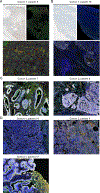Combination Targeted Therapy with Pembrolizumab and Lenvatinib in Progressive, Radioiodine-Refractory Differentiated Thyroid Cancers
- PMID: 38922338
- PMCID: PMC11883846
- DOI: 10.1158/1078-0432.CCR-23-3417
Combination Targeted Therapy with Pembrolizumab and Lenvatinib in Progressive, Radioiodine-Refractory Differentiated Thyroid Cancers
Abstract
Purpose: Lenvatinib, a potent multikinase inhibitor, improves progression-free survival (PFS) in patients with radioiodine (RAI)-refractory differentiated thyroid cancer; however, most patients experience disease progression, warranting further therapy. We evaluated the efficacy and safety of lenvatinib plus pembrolizumab in these patients.
Patients and methods: We enrolled patients with progressive, RAI-refractory differentiated thyroid cancer who were either naïve to multikinase inhibitors (cohort 1) or who had progressed on lenvatinib (cohort 2). Patients received oral lenvatinib daily (cohort 1, 20 mg; cohort 2, dose at progression) and intravenous pembrolizumab (200 mg) every 21 days.
Results: In cohorts 1 and 2, 30 and 27 patients were enrolled, respectively. Adverse events were consistent with those observed in other cancers. In cohort 1, the confirmed overall response rate was 65.5%. There were no complete responses (primary endpoint). The 12- and 18-month PFS were 72.0% and 58.0%, respectively, and the median PFS was 26.8 months. In cohort 2, the confirmed overall response rate was 16% (primary endpoint), and the median PFS was 10.0 months (95% confidence interval, 7.0-17.9 months). Tumor histology, driver mutations, and immune-related biomarkers, including PD-L1 expression, thyroid-specific antibody levels, and CD8+ T-cell tumor infiltrate, did not correlate with response to therapy. Increased baseline peripheral blood monocytes and neutrophil to lymphocyte ratio were associated with a worse PFS in cohort 1.
Conclusions: Lenvatinib plus pembrolizumab may enhance the durability of lenvatinib monotherapy in lenvatinib-naïve patients. Furthermore, the addition of pembrolizumab may be a viable salvage therapy for patients who have progressed on lenvatinib.
©2024 American Association for Cancer Research.
Figures




References
-
- Durante C, Haddy N, Baudin E, Leboulleux S, Hartl D, Travagli JP, et al. Long-term outcome of 444 patients with distant metastases from papillary and follicular thyroid carcinoma: benefits and limits of radioiodine therapy. J Clin Endocrinol Metab 2006;91:2892–99. - PubMed
-
- Haugen BR, Alexander EK, Bible KC, Doherty GM, Mandel SJ, Nikiforov YE, et al. 2015 American thyroid association management guidelines for adult patients with thyroid nodules and differentiated thyroid cancer: the American Thyroid Association Guidelines Task Force on thyroid nodules and differentiated thyroid cancer. Thyroid 2016;26:1–133. - PMC - PubMed
-
- Shoup M, Stojadinovic A, Nissan A, Ghossein RA, Freedman S, Brennan MF, et al. Prognostic indicators of outcomes in patients with distant metastases from differentiated thyroid carcinoma. J Am Coll Surg 2003;197:191–97. - PubMed
-
- Okamoto K, Kodama K, Takase K, Sugi NH, Yamamoto Y, Iwata M, et al. Antitumor activities of the targeted multi-tyrosine kinase inhibitor lenvatinib (E7080) against RET gene fusion-driven tumor models. Cancer Lett 2013;340:97–103. - PubMed
MeSH terms
Substances
Grants and funding
LinkOut - more resources
Full Text Sources
Medical
Research Materials

